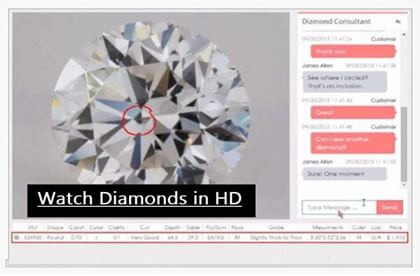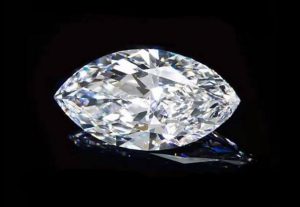Executive summary
The 4Cs of a diamond is the parameter for evaluating a grading a diamond. The cut determines the fire, brilliance, and scintillation in the diamond. The carat weight is a function of the diamond’s weight but the clarity has to do with impurities and blemishes on the diamond.
VVS is the short form for very very slightly included. Diamonds with this clarity grade usually have very very small inclusions that cannot be seen with the naked eye.it is one of the highest clarity grades and the inclusion are so small that even under 10X magnification, it’s difficult to still see them. The inclusions that are found in the VVS diamonds are benign inclusions. These inclusions like clouds, internal graining, pinpoints, and feathers are not found on the surface of the diamond and generally do not affect the physical appearance of the diamond.
There are two categories of VVS clarity. We have the VVS1 and the VVS2 categories. The difference between these two categories is based on the position of the inclusion in the diamond. The inclusions in the VVS1 diamonds are closer to the edges of the stone while the inclusions in the VVS2 diamonds are closer to the center of the diamond. When viewing the diamond from the top, it is harder to spot inclusions in the VVS1 diamonds than in the VVS2 diamonds.
There are 5 inclusions commonly found in diamonds with VVS clarity grade; pinpoints, cloud, internal graining, feather, and needles.
If anyone looks at the VVS diamonds with just the naked eye, they get the feeling that it is a flawless diamond. It is in fact ranked under the category of flawless diamonds. A buyer settling for a VVS diamond is actually settling for a ‘flawless’ diamond at a comparatively cheaper price.
There are 4 parameters known as the 4Cs used to grade the value of a diamond. These parameters are cut, color, clarity and carat weight. All the 4 parameters can be used to independently determine the value of a diamond and they all have a bearing on the overall price of the diamond.
A diamond cut determines the fire and brilliance of the diamond. The carat weight of the diamond determines the size of the diamond. Clarity, on the other hand, has to do with the visibility of impurities and blemishes in and on the diamond.
Based on the clarity characteristics, there are different grades of diamond clarity. The best-known clarity grade is the Flawless grade, where the diamond does not have any inclusions or blemishes in or on it. While the least clarity grade is the Included grade, where the inclusions in the diamond are very noticeable by the naked eye.
What is VVS?
VVS (which is the short form for very very slightly included) is actually one of the highest clarity grades for diamond. Diamonds with this clarity grade usually have very very small inclusions that cannot be seen with the naked eye. As a matter of fact, the diamonds are so clear that even under a magnification of 10x, it is still difficult to see the inclusions.
There are two categories of VVS clarity. We have the VVS1 and the VVS2 categories. The difference between these two categories is based on the position of the inclusion in the diamond. It cannot be seen with the naked eye but is determined under a microscope.
The inclusions that are found in the VVS diamonds are benign inclusions. These inclusions like clouds, internal graining, pinpoints, feathers are not found on the surface of the diamond and generally do not affect the physical appearance of the diamond.
The inclusions in the VVS1 diamonds are closer to the edges of the stone while the inclusions in the VVS2 diamonds are closer to the center of the diamond. When viewing the diamond from the top, it is harder to spot inclusions in the VVS1 diamonds than in the VVS2 diamonds. You have to turn the diamond upside down and view it under the microscope to see the impurities in the VVS1 diamond. So it is relatively more difficult to find impurities in VVS1 diamonds than in VVS2 diamonds. With VVS2 diamonds, you can see the impurity through the crown of the diamond. That is the reason why VVS1 diamonds are considered to have better clarity and is higher up the clarity grade than the VVS2 diamonds.
Typical inclusions found in VVS diamonds
Different types of inclusions can be found in diamonds. The type, positions, and size of these inclusions go a long way in determining the long term durability of the diamond. For VVS diamonds, there are 5 inclusions commonly found in them.
- Pinpoints: These are small mineral deposits in a diamond. They are usually noticed under magnification. The mineral deposits can be found in clusters or are solitary in the diamond.
- Clouds: When there is a cluster of pinpoints in a diamond, it forms a cloud of pinpoints.
- Internal graining: This is caused by an abnormality in the growth of the crystal structure. It results in a wave-like pattern that is uneven.
- Needles: They appear like tiny rods when viewed under 10x magnification but they are in reality thin, elongated crystals.
- Feathers: These are fractures or small cracks that can only be seen under magnification in the VVS diamonds. But they can be more visible in lower clarity grades. They are usually formed when the diamond is being formed, not when it is being cut.
Differentiating VVS Diamonds from Other Lower Clarity Grade
One way that graders can differentiate between VVS diamonds and diamonds with lower clarity grade is the size of the inclusion in the diamond. It usually takes a very powerful microscope to see inclusions in the VVS grade and the inclusions are not so big. So if the inclusion is so big that it is relatively ‘easy’ to view under 10x magnification, it is seen as lower than VVS. Another thing that graders look out for is the number of inclusions in the diamond. The more the number of inclusions in the diamond, the lower the quality of the clarity. So if the inclusions in the diamond are so much that they are readily seen under magnification, the diamond cannot be classified as a VVS diamond.
Why Is VVS A Good Diamond Clarity Grade?
If anyone looks at the VVS diamonds with just the naked eye, they get the feeling that it is a flawless diamond. As a matter of fact, it is ranked under the category of flawless diamonds. It takes only an expert with the right tools and the right magnification to see the flaws in these diamonds. So when these diamonds are compared with the real flawless diamonds, the customers are the ones at an advantage. This is because the flawless diamonds are graded higher than the VVS diamonds, so they are typically more expensive. A buyer settling for a VVS diamond is actually settling for a ‘flawless’ diamond at a comparatively cheaper price. The flaws are only seen under magnification and no one carries a magnifying glass or a microscope about with the aim of confirming the flawlessness of another’s diamond. It is flawless to the naked eye and it is cheaper than the flawless diamond. That is the advantage for the buyer.
If you consider the rareness of flawless diamonds as well, you will realize that it might be a difficult task to find a flawless diamond that meets your requirement for cut, color and carat weight. So the ideal alternative is to settle for the next best flawless diamond that is cheaper and more available.
Another advantage that you get with VVS diamonds apart from its beauty and flawlessness is its profitability. VVS diamonds and diamonds with higher clarity grades tend to appreciate in the market very quickly. So whatever the price you buy it, you can be sure that it is very likely going to increase in the future. So for the buyer, the sooner you buy it, the better. It becomes more profitable for you especially if you are looking to sell it on again. This is very much unlike other diamonds with lower clarity grade than VVS. They also tend to appreciate but not as quickly as VVS and higher diamonds.
Should I Buy A VVS Diamond?
The question of whether or not to buy a VVS diamond is first based on personal preference and a combination of other factors.
For the sake of affordability, VVS diamonds are more expensive than diamonds with lower clarity grades. If you are looking to minimize your spending, it would not be a good idea to buy a VVS diamond. You can settle for a VS diamond, even some S1 diamonds appear eye-clean. So a VVS diamond might be a little over the top.
If you are a purist and believe in buying only flawless diamonds, then VVS diamonds might be the right choice for you. Reason being that it is quite difficult to find diamonds with the flawless grade, even if you do, finding one with the exact cut, color, and carat weight that you require might be a huge challenge. But with VVS diamonds, you can easily meet up with these requirements and still have the feel of owning a pure and flawless diamond.




